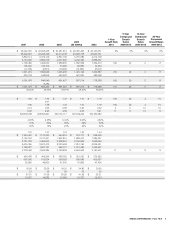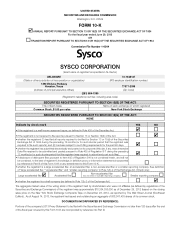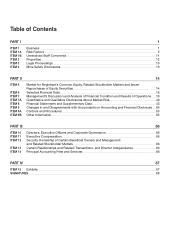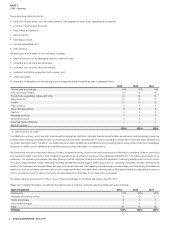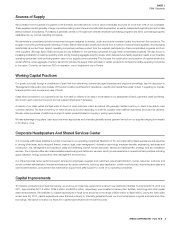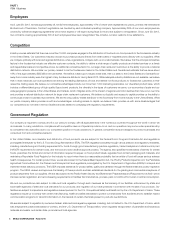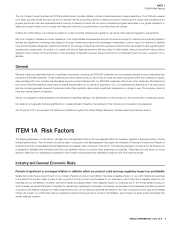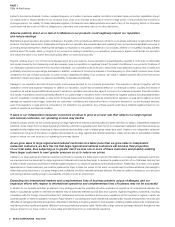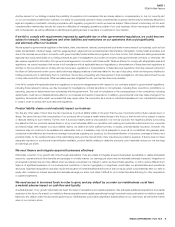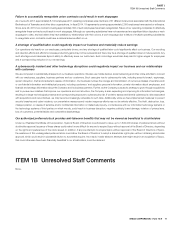Sysco 2013 Annual Report Download - page 18
Download and view the complete annual report
Please find page 18 of the 2013 Sysco annual report below. You can navigate through the pages in the report by either clicking on the pages listed below, or by using the keyword search tool below to find specific information within the annual report.SYSCO CORPORATION-Form10-K 7
PARTI
ITEM1ARisk Factors
•an operating cost transformation initiative to lower our cost structure;
•
a product cost reduction and category management initiative to use market data and customer insights to make changes to product pricing and
product assortment; and
•several other initiatives.
Although we expect the investment in the Business Transformation Project to provide meaningful bene ts to the company over the long-term, the costs
exceeded the bene ts during the testing stages of implementation of ERP, including in scal 2013. Successfully managing deployment is critical to our
business success. While we expect all of the components of the Business Transformation Project to enhance our value proposition to customers and suppliers
and improve our long-term pro tability, there can be no assurance that we will realize our expectations within the time frame we have established, if at all.
The actual cost of the ERP system may be greater or less than currently expected and continued delays in the
execution of deployment may adversely affect our business and results of operations
ERP implementations are complex and time-consuming projects that involve substantial investments in system software and implementation activities over
a multi-year timeframe. Our cost estimates related to our ERP system are based on assumptions which are subject to wide variability, require a great deal of
judgment, and are inherently uncertain. Thus, the actual costs of the project in scal 2014(and beyond) may be greater or less than currently expected. We have
encountered, and we may continue to encounter, the need for changes in design or revisions of the project calendar and budget, including incurring expenses
at an earlier or later time than currently anticipated. For example, we deployed our ERP system to three additional locations in scal 2013 and are experiencing
improved functionality in many areas compared to past deployments; however, while the majority of the system functionality is performing as designed, we
have identi ed areas of improvement to certain components of the system that we want to address before we continue deploying to additional locations.
In addition, implementation of the systems require signi cant management attention and resources over an extended period of time and any signi cant
design errors or further delay in the implementation of the systems could materially and adversely affect our operating results and impact our ability to
manage our business. Continued delays in deployment, additional operating problems discovered in the underlying information technology systems’
processes, cost overages or limitations on the extent of the business transformation during the ERP implementation process adversely affect our business
and results of operations. In addition, because the implementation is expected to continue to involve a signi cant nancial commitment, our business,
results of operations and liquidity may also be adversely affected if the ERP system, and the associated process changes, do not prove to be cost effective
or do not result in the cost savings and other bene ts at the levels that we anticipate. There can be no guarantee that we will be able to realize the intended
results of the system software and implementation activities. We expect costs to continue to outweigh bene ts for scal 2014 as we continue deployment.
We may not realize anticipated benefi ts from our operating cost reduction efforts
We have implemented a number of cost reduction initiatives that we believe are necessary to position our business for future success and growth. Our
future success and earnings growth depend upon our ability to achieve a lower cost structure and operate ef ciently in the highly competitive food and
beverage industry, particularly in an environment of increased competitive activity and reduced pro tability. A variety of factors could cause us not to realize
some of the expected cost savings, including, among other things, delays in the anticipated timing of activities related to our cost savings initiatives, lack
of sustainability in cost savings over time and unexpected costs associated with operating our business. If we are unable to realize the anticipated bene ts
from our cost cutting efforts, we could become cost disadvantaged in the marketplace, and our competitiveness and our pro tability could decrease.
Furthermore, even if we realize the anticipated bene ts of our cost reduction efforts, we may experience an adverse impact on our employees and customers
which could negatively affect our sales and pro ts.
We may not realize the full anticipated benefi ts from our category management initiative
We are in the midst of deploying our category management initiative which encompasses a rigorous process whereby we use market data and customer
insights to optimize the product assortment available to our customers, strengthen strategic relationships with our suppliers, and increase our sales and pro t
margins. If our sales associates are not able to effectively gain acceptance of the new product assortment from our customers, or we and our suppliers are
not able to absorb the signi cant administrative and process changes required, then we may not be able to successfully execute the category management
initiative in the timeline we anticipate and we may not capture the nancial and other bene ts at the levels that we anticipate, or at all. Furthermore, even if
we realize the anticipated bene ts of our category management initiative, we may experience an adverse impact on our employees and customers which
could negatively affect our sales and pro ts.
Conditions beyond our control can interrupt our supplies and increase our product costs
We obtain substantially all of our foodservice and related products from third-party suppliers. For the most part, we do not have long-term contracts with our
suppliers committing them to provide products to us, however we believe the number of long-term contracts will increase as we progress with our category
management initiative. Although our purchasing volume can provide bene ts when dealing with suppliers, suppliers may not provide the foodservice products
and supplies needed by us in the quantities and at the prices requested. We are also subject to delays caused by interruption in production and increases
in product costs based on conditions outside of our control. These conditions include work slowdowns, work interruptions, strikes or other job actions by
employees of suppliers, short-term weather conditions or more prolonged climate change, crop conditions, water shortages, transportation interruptions,
unavailability of fuel or increases in fuel costs, product recalls, competitive demands and natural disasters or other catastrophic events (including, but not



